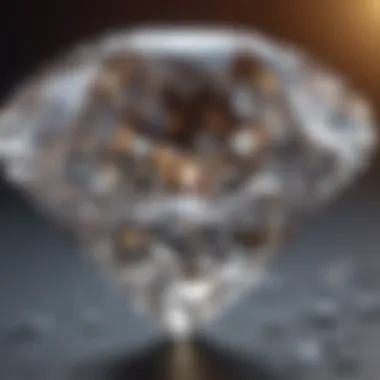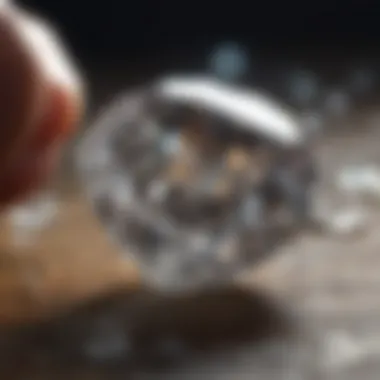Understanding Diamonds: Their Value and Significance


Intro
Diamonds, often regarded as the pinnacle of luxury, hold a unique position among gemstones. This section aims to dissect the various characteristics that define diamonds and how they are perceived within society. From their formation deep within the Earth to their ultimate adornment in jewelry, diamonds encompass a wide array of traits that set them apart from other gemstones.
The allure of diamonds transcends mere physical appearance; their cultural significance and the aura of romance and prestige attached to them play a critical role in their desirability. Understanding diamonds goes beyond appreciating their sparkle; it involves exploring their mineral composition and the geological processes that create them.
This article will delve into key aspects, including the distinction between diamonds and other gemstones, their inherent value, and their application in different spheres. By the end, readers will gain a rich comprehension of diamonds—not just as precious stones, but as essential components of the gemological landscape.
Characteristics of Diamonds
Diamonds possess several distinguishing features that make them unique. Below are some vital elements:
- Hardness: On the Mohs scale, diamonds are rated a 10, making them the hardest natural material known. This hardness ensures durability, which is crucial for jewelry.
- Brilliance and Fire: Their ability to refract light brilliantly results in a sparkling appearance. The dispersion of light creates a colorful display known as
Prelims to Gemstones
The study of gemstones represents a fascinating intersection of science, history, and culture. Understanding gemstones is essential for comprehensively grasping their significance across various domains, including jewelry, astrology, and overall aesthetics. By delving into the intricacies of gemstones, one can appreciate their roles in human culture, symbolism, and as manifestations of natural beauty. This section sets the stage for exploring the unique attributes of diamonds, those most celebrated of all gemstones, within the broader context of gemology.
Definition of Gemstones
Gemstones, in essence, are mineral crystals, organic materials, or petrified matter that have been cut, polished, and utilized for ornamental purposes. They possess an innate beauty or durability that qualifies them for consideration as precious or semi-precious stones. The classification can often vary based on cultural significance, rarity, or aesthetic appeal. Most commonly, gemstones are identifiable through specific characteristics such as hardness, refractive property, and color.
Gemstones can be categorized into several types:
- Precious gemstones: Includes diamonds, sapphires, rubies, and emeralds. These stones are generally rare and more valuable.
- Semi-precious gemstones: These are more common and include stones like amethyst, topaz, and garnet.
The value of gemstones arises not solely from their beauty but also from their symbolic meanings and historical contexts. For instance, diamonds often symbolize strength and eternal love.
Historical Perspective on Gemstones
Historically, gemstones have been revered across cultures for their beauty, rarity, and often mystical properties. From ancient civilizations to modern times, they have held cultural, economic, and spiritual importance.
In ancient Egypt, for example, gemstones were utilized in jewelry and burial artifacts. They were believed to possess protective qualities and were associated with various deities. Similarly, in ancient India, gemstones played an integral role in astrology and were often linked to luck and fate. The fascination with these stones persisted throughout history, firmly cementing their place in affluent cultures.
Significant periods in gemstone history include:
- The Renaissance: A resurgence in the value of gemstones, where they were seen as symbols of power and wealth.
- The Industrial Revolution: Advances in technology allowed for more widespread access to gemstones, changing the market dynamics.
Today, gemstones continue to evolve in significance, adapting to changing values and perceptions worldwide. This historical perspective provides a backdrop against which the unique qualities of diamonds can be thoroughly examined.
The Nature of Diamonds
The subject of the nature of diamonds holds significant relevance in understanding their role in the world of gemstones. This section explores various attributes that make diamonds unique and essential in both gemology and cultural contexts. By dissecting their structure, formation, and origin, readers gain insight into why diamonds are not just ornamental but also valuable commodities. The interplay of natural and technological factors contributes to our understanding of diamonds' intrinsic worth and cultural positioning.
Diamond Composition
Carbon Structure
Diamonds are primarily composed of carbon atoms arranged in a specific lattice structure. This arrangement is what gives diamonds their unparalleled hardness, making them the hardest known natural material. The key characteristic of carbon structure lies in the way carbon atoms link through strong covalent bonds, allowing for extraordinary resilience and durability.
A notable aspect of the carbon structure is its crystalline arrangement, which defines how light interacts with the diamond, generating brilliance and fire in these gemstones. This optic property is a major consideration for jewelers and collectors who value clarity and sparkle in diamonds. However, the rigid structure can present challenges; any inclusions or blemishes may significantly impact perceived quality.
Crystalline Form
The crystalline form of diamonds, known as isometric, plays a crucial role in their overall aesthetics and commercial value. This three-dimensional geometric structure allows for maximal light entry and reflection, critical factors in determining a diamond's brilliance and value. The unique feature of this crystalline form is its symmetry, which not only leads to captivating light dispersion but also influences the cutting styles in diamond jewelry.


Choosing diamonds based on their crystalline form is beneficial for aesthetic appeal, as finely cut diamonds can drastically affect a piece's overall visual impact. Nevertheless, the rapid technological advances in cutting techniques can sometimes lead to variations that are less appreciated by purists focused on traditional artisan methods.
Origin and Formation of Diamonds
Geological Processes
The geological processes responsible for diamond formation take place under extreme heat and pressure, typically at depths of 150 to 200 kilometers within the Earth’s mantle. This natural creation involves the crystallization of carbon over billions of years, leading to the formation of these precious stones. The significance of geological processes lies in their ability to produce diamonds with unique properties based on their formation environment, including color variants and clarity levels.
A key beneficial aspect of these geological processes is that they contribute to the rarity of diamonds. The intricate conditions required for diamond formation mean that high-quality stones are relatively uncommon. However, the lengthy timescale also raises concerns about the sustainability of diamond mining and its environmental impacts.
Mining Techniques
Mining techniques for diamonds vary and can include methods such as open-pit mining and underground mining. Each technique has distinct implications for both yield and environmental considerations. Open-pit mining, for instance, allows easy access to diamond-bearing rock but can significantly disrupt local ecosystems.
One notable characteristic of modern mining techniques is their technological integration. Innovations in diamond extraction not only improve efficiency but also aim to minimize environmental degradation. However, ethical considerations arise, particularly concerning the sourcing of diamonds and the potential for human rights violations in mining areas. It is vital to discuss these challenges to ensure responsible practices and support ethical sourcing.
Diamonds symbolize more than mere luxury; they encapsulate layers of historical and cultural narratives shaped by their geological origins and methods of extraction.
This exploration of diamond composition and geological origins serves to deepen appreciation of these gemstones. Through understanding their inherent characteristics, individuals can make informed choices whether for personal adornment or investment purposes.
Classification of Gemstones
Classifying gemstones is vital in comprehending their allure and role in the world. This classification aids not only in identifying their intrinsic properties but also in valuating and categorizing them. Gemstone classification fosters a structured approach to understanding their qualities and market dynamics, which can be particularly valuable for collectors, jewelers, and consumers alike.
In the context of diamonds, understanding classification allows us to differentiate them from other gemstones, underscoring their unique characteristics and value propositions. The classification considers various criteria, enhancing our appreciation of their contributions to art, culture, and investment.
Criteria for Gemstone Classification
Rarity
Rarity is a cornerstone of classification for gemstones, including diamonds. This trait often dictates value, with fewer available stones commanding higher prices. Diamonds, although more abundant than some gemstones, still hold significant rarity dependent on factors like color or clarity. This rarity enhances the allure for collectors and buyers seeking exclusivity.
A diamond that displays unique color, like the Pink Diamond, is exceedingly rare. Buyers often pursue these stones due to their limited availability, driving prices higher. However, the rarity can also lead to inflated perceptions of value, which may not always align with market demand.
Durability
Durability is another crucial criterion in gemstone classification. Diamonds are famed for their hardness, rated 10 on the Mohs scale, making them the hardest naturally occurring material. This exceptional durability makes diamonds suitable for daily wear, a trait not shared by all gemstones.
Consumers appreciate this resilience, viewing diamonds as practical choices for engagement rings and other jewelry designed for frequent use. However, while high durability is advantageous, it can create misconceptions regarding care. Although durable, diamonds can chip or fracture under extreme conditions, something potential buyers should consider.
Beauty
Beauty is perhaps the most subjective aspect of classifying gemstones. The aesthetic appeal of diamonds, which is shaped by their cutting, clarity, and color, manifests their inherent beauty. However, beauty can diverge vastly among individuals. Some might favor the classic clear diamond, while others might be drawn to colored diamonds or other gemstones for their unique hues.
The beauty of diamonds is also showcased through the skill of the cutter, which enhances brilliance and sparkles. This craftsmanship plays a critical role in the stone's overall appeal. However, subjective preferences can complicate the evaluation, leading to disparities between perceived beauty and market value.
Comparison with Other Gemstones
Sapphires
Sapphires are popularly recognized as a formidable counterpart to diamonds. While diamonds are primarily valued for their clarity and brilliance, sapphires offer various colors, although blue is the most revered. Sapphires can be significantly less expensive than diamonds while offering beauty and durability. This can make them an attractive choice for consumers who seek quality without the diamond price tag.
However, sapphires might not hold the same status as diamonds in traditional engagement settings, which could influence buyers’ perceptions.
Rubies


Rubies, with their striking red hue, stand out in the gemstone world, showcasing their appeal through vibrant colors. Much like diamonds and sapphires, rubies are durable but often have inclusions that impact their clarity. Despite this, high-quality rubies can be priced competitively with diamonds, especially in the luxury market.
The unique allure of rubies might sway buyers looking for distinctiveness but can also pose challenges in clarity grading, complicating their appraisal alongside diamonds.
Emeralds
Emeralds capture attention with their rich green color, providing a contrast to the typical diamond color spectrum. While emeralds are cherished, they are generally considered less durable than diamonds due to their tendency for inclusions. This leads to a complexity in usage, where consumers might select emeralds for specific occasions rather than daily wear.
Emeralds can be an attractive option for buyers desiring color, yet their market position is often lower than diamonds, impacting how they are perceived in value discussions.
Understanding the criteria used in gemstone classification enhances both appreciation and informed purchasing decisions.
Diamonds in Culture and Society
The significance of diamonds in cultural contexts cannot be overstated. Throughout history, diamonds have not only been symbols of luxury but also have served deeper meanings in the lives of individuals and societies. Their lustrous appearance and rarity give them a unique status, serving both aesthetic and practical purposes in jewelry and beyond. This section delves into the various dimensions of diamonds, focusing on their symbolism, significance, and influence on jewelry design.
Symbolism and Significance
Love and Commitment
Diamonds play a crucial role in expressing love and commitment. Traditionally, engagement rings are crafted with diamonds, as they symbolize eternal love. The idea is that, just as diamonds are formed under extreme pressure, true love can withstand challenges over time. This connection enhances the allure of diamonds as a representation of lifelong promises. The key characteristic of love and commitment associated with diamonds is their durability; much like a strong relationship, diamonds are resilient and resistant to change. However, this notion can also be viewed as a potential disadvantage, as it creates pressure on individuals to invest in such significant pieces.
Status and Wealth
The association of diamonds with status and wealth is another crucial aspect. Throughout history, owning and displaying diamonds has been a clear indicator of social standing. They are often used in elaborate jewelry pieces worn by the elite, showcasing their richness and social class. The key characteristic here is exclusivity, which perpetuates the desire for diamonds among affluent individuals. While this enhances the desirability and value of diamonds, it can also lead to a disconnect with those who view diamonds as merely luxury items rather than symbols of personal significance.
Influence on Jewelry Design
Cutting Techniques
Cutting techniques significantly impact the beauty and appeal of diamonds. The precision of cuts determines how light interacts with the stone, thereby enhancing its brilliance and fire. Techniques such as the round brilliant cut or the princess cut showcase unique attributes and maximize the diamond's potential. The key characteristic of these cutting techniques is their ability to optimize visual appeal, making diamonds an appealing choice for jewelry designers. However, more elaborate cuts require more skilled craftsmanship, which can elevate the cost of the final product.
Popular Settings
Popular settings for diamonds play a vital role in their presentation. Various settings maximize their aesthetic appeal and complement the diamond's brilliance. For instance, the solitaire setting emphasizes the diamond's beauty, while halo settings add additional sparkle. The key characteristic of these settings is that they create a frame for the diamond, highlighting its unique features. However, choosing the wrong setting might overshadow the diamond's allure, thus affecting its overall impact in jewelry.
Diamonds represent more than just luxury; they convey deep cultural meanings tied to love, status, and artistry in design, making them truly unique gemstones.
The Value Proposition of Diamonds
Diamonds hold a significant place in the gemstone market, both for their aesthetic appeal and market value. Understanding the value proposition of diamonds involves looking at various factors that influence their prices and how they are viewed as investments. This section delves into components that contribute to the overall worth of diamonds, including physical characteristics and market dynamics.
Factors Influencing Diamond Prices
Carat Weight
Carat weight is a major factor when determining the price of a diamond. It reflects the size of the diamond and is measured in carats. The main characteristic of carat weight is that it can dramatically impact the price. Usually, larger stones have a significantly higher price per carat, which makes larger diamonds more coveted.
The unique feature of carat weight lies in its direct correlation to size. A diamond that weighs one carat is noticeably larger than one that weighs half a carat. In this context, a larger carat weight may suggest a more impressive appearance, which makes it a popular choice for buyers looking for stand-out pieces.
However, prospective buyers must consider that larger carat diamonds can be less accessible to those on a budget. The steep increase in price with carat weight necessitates careful planning. While larger stones attract admiration, they may pose budgetary constraints.
Color
Color is another critical factor in assessing a diamond's value. The Gemological Institute of America (GIA) rates diamond color on a scale from D (colorless) to Z (light yellow or brown). A key characteristic of color is its subtle influence on the overall appearance of the diamond. Colorless diamonds tend to be more sought after, elevating their market value.


The unique feature of diamond color is that even slight variations can lead to significant differences in price. A diamond with a color grade of E may cost several thousand dollars more than an F-grade diamond, though visually they might appear similar. This pricing consequence underscores the importance of color grading when purchasing.
However, some buyers appreciate the warmth of colored diamonds, such as fancy yellow or pink options. These can sometimes offer better accessibility in the market, as unique colors may exhibit different demand dynamics. Understanding personal preference and market trends can guide buyers in making informed choices.
Clarity
Clarity refers to the presence of internal or external imperfections in a diamond, known as inclusions and blemishes. The grading scale ranges from Flawless (no inclusions visible under 10x magnification) to Included (inclusions visible to the naked eye). Clarity is highly instrumental in determining a diamond's allure and, consequently, its price.
Clarity allows for some unique features, as higher clarity grades can enhance the sparkle and overall visual aesthetic of the diamond. A high-clarity stone will generally reflect more light, contributing to its beauty. Models like VVSI (Very Very Slightly Included) can find a good balance between clarity and pricing, making them attractive to buyers.
Nevertheless, buyers must understand that while clarity is important, some inclusions are imperceptible without magnification, and thus, they may not detract from the overall experience of the diamond. A careful consideration of clarity can lead to more cost-effective decisions.
Investment Potential
Investing in diamonds extends beyond mere ownership. Diamonds have potential as a hedge against inflation and a means of diversifying portfolios. The rarity of diamonds and their intrinsic value make them appealing as an investment option. However, this only holds if buyers are informed and aware of market trends.
Consideration of the types of diamonds that are typically best for investment—such as those with superior quality ratings—can lead to potentially lucrative returns. Furthermore, factors such as changes in demand and supply within the diamond market are crucial in predicting future value trajectories.
Environmental and Ethical Considerations
Diamonds hold a unique position in our cultural and social landscapes, making it essential to explore the environmental and ethical implications of their sourcing and use. This section emphasizes the significance of sustainable practices and the need for responsible sourcing in protecting both the environment and human rights.
Sustainable Mining Practices
Sustainable mining practices focus on methods that minimize environmental impact and promote social justice. The diamond industry has made strides towards establishing more sustainable practices over the years. These practices are crucial in ensuring that diamond mining does not result in ecological degradation or social displacement.
Key Elements of Sustainable Mining:
- Land Rehabilitation: After mining, restoring land to its natural state is important. This includes reforesting and managing wildlife habitats.
- Water Management: Efficient water use and waste management practices can reduce the strain on local water sources.
- Community Engagement: Involving local communities in decision-making processes is fundamental. This ensures that the interests of those affected by mining operations are represented.
By focusing on these practices, the industry can work towards a balance between economic benefits and environmental preservation.
Conflict Diamonds and Responsible Sourcing
Conflict diamonds, also known as
Epilogue
The significance of the conclusion in this article is paramount. It serves as a summation of the insights gathered from the detailed exploration of diamonds. Not only does it encapsulate the multifaceted nature of diamonds as gemstones, but it also reaffirms their unique attributes. The essence of diamonds is not solely in their composition or resale value, but also in their cultural implications and timeless appeal.
A comprehensive understanding of diamonds equips individuals with the knowledge to appreciate their beauty and significance. This appreciation transcends mere aesthetic value; it extends into areas such as investment, emotional attachment, and ethical consideration in sourcing.
In terms of benefits, we see that recognizing the diverse roles diamonds play can influence purchasing decisions. It enhances the understanding of what makes them distinct from other gemstones like sapphires and rubies. Furthermore, awareness regarding environmental and ethical considerations cultivates a more responsible attitude among consumers. These factors, when considered, can create an informed choice that aligns with one's values and ethical standards.
The discussion surrounding diamond values—carat, weight, clarity—underscores the financial aspects, while simultaneously promoting an awareness of how cultural perceptions shape one's view toward these gemstones.
Understanding diamonds thus becomes an interplay of beauty, value, and ethical awareness that cultivates a richer appreciation for these gemstones in modern society.
Final Thoughts on Diamonds as Gemstones
In closing, diamonds represent much more than mere luxury items; they are a blend of science, culture, and emotion. As a gemstone, they encapsulate human desires that span centuries. Their role in engagement and wedding traditions solidifies their status as symbols of love and commitment.
As we have reviewed in this article, the differentiation of diamonds from other gemstones is crucial.
- Their unique composition and properties play a vital role in their appeal.
- The historical context enriches their cultural significance.
- Their ethical sourcing considerations mark a modern shift in consumer attitudes.
For astrologers, tarologists, and esotericists, the symbolism attached to diamonds can be deeply insightful. They are perceived as powerful stones that harness certain energies
"Diamonds, with their unmatched brilliance and durability, also reflect the inner strength one can cultivate through challenges."
By recognizing the complexities of diamonds as gemstones, both in their physical and symbolic characteristics, we offer a profound understanding for anyone who seeks to integrate their meaning into spiritual or personal practices. Ultimately, diamonds hold a position that is as relevant today, as it has been throughout history.







